Table Of Content3
S
Much lias been written about the Rashtrapati Bhavan as a
20th century ‘palace’ that once lay at the heart of a British
imperial vision of India and later on, as the centre of
democratic republicanism in the modern nation of India.
However, very little is known about the vast estate that
lies behind the facade of the main building. This volume
sheds light on the symbiotic and organic oneness between
the main building, the home to the president and his/her
family, and the vast 330-acre estate, which is currently
home to nearly 1000 households.
The microcosm of the estate is, indeed, a vital part of
the macro-history of a constantly changing and evolving
landscape in the history of India—and, indeed. South
Asia. Tracing its origins in the late colonial period
where the viceregal families employed numerous family
retainers to service the household and estate, this volume
also looks into the dynamic transformation in the post-
Independence period, during which the estate was
reinvented as a democratic space. The intention is to bring
out the grandeur of life in the seat of the head of state
on one hand and, on the other, the intimacy of life in
a small, self-contained community. As a landscape, the
Rashtrapati Bhavan is sedimented with memories: of the
long-term residents, who have stayed on for generations, as
well as the more short-term counterparts, who have been
posted at the Rashtrapati Bhavan for a fixed tenure. This
volume seeks to recover and re-tell these half-forgotten
narratives and has conducted extensive interviews to
present a history from below.
As the culminating volume in a series of books
documenting the rich social, cultural and historical
significance of the Rashtrapati Bhavan, Life at Rashtrapati
Bhavan, aims to chart out the various forms taken by
the building and its estate: from symbol of imperial
domination to one of national pride, from private home(s)
to a public monument and, more recently, as a model
township of the nation.
RASHTRAPATI BHAVAN, NEW DELHI
iSH
LIFE
AT
RASHTRAPATI BHAVAN
left. The Rashtrapati Bhavan is the first port of call for visiting heads of state. Seen here is the president of the United States of America, Barrack Obama, at his
formal reception at the Rashtrapati Bhavan as the chief guest at the Republic Day parade, 2015. He receives the salute from the guard of honour in the forecourt
yni s **^9K*S
'l
: V ’
LIFE
AT
RASHTRAPATI BHAVAN
Edited by
Sudha Gopalakrishnan
&
Yashaswini Chandra
Photography by
Dinesh Khanna
Published by Publications Division, Government of India
The first Indian President Rajendra Prasad leaves the Rashtrapati Bhavan in the state carriage, 1952 (Source: Rashtrapati Bhavan Photo Section)
LIFE AT RASHTRAPATI BHAVAN
© 2016, Rashtrapati Bhavan, New Delhi, India
Commissioned by the President’s Secretariat, Rashtrapati Bhavan, and Indira Gandhi
National Centre for the Arts (IGNCA), Ministry of Culture, Government of India
Executed by Sahapedia
Edited by Sudha Gopalakrishnan andYashaswini Chandra
Principal Photography by Dinesh Khanna, 2014—16
Additional Photography by Narendra Bisht, Ram Rahman,
Dheeraj Paul and Joginder Singh
Other Photos: Photo Section, Rashtrapati Bhavan; President's Bodyguard (PBG)
Album; Press Information Bureau (PIB), Ministry of Information and Broadcasting,
Government of India; Alkazi Collection of Photography, India; Country Life
Magazine, UK; Imperial War Museum, UK; The National Science Museum, UK; The
City Palace,Jaipur; Sneh Govind Singh; Saurabh Oliver Sinclair; and Niloufer Menon
Resource PersomVenu Rajamony, press secretary to the president
Researchers: Adhitya Dhanapal,Vishal Singh Deo, Ektaa Jain and Priyanka Seshadri
Editorial Consultant: Nirmal K. Bhattacharjee
Editorial Assistance: Dipali Singh
Designed by Yamini Gandhi, Incarnations Design
Production CoordinatiomV.K. Meena, Publications Division
Printed by Nutech Print Services - India
Note: Opinions expressed by the authors are theirs alone, and do not necessarily
reflect the opinions of the Rashtrapati Bhavan or any employee thereof.
PRICE: ^ 1510
All rights reserved.
ISBN: 978-81-230-2298-7
No part of this publication may be reproduced or transmitted in any form
by or by any means, electronic or mechanical, without permission in RB-ENG-OP-067-2016-17
writing from the Presidents Secretariat and the Publications Division.
Published by
Every effort has been made to obtain permission to use the images published in
this book and/or acknowledge the copyright holders. In case there is any objection
pertaining to copyright or if any copyright holder has not been acknowledged Additional Director General
inadvertently, the publishers encourage that such cases may be brought to Publications Division
their notice and the same will be rectified appropriately in future edition. Ministry ot Information and Broadcasting, Government of India

